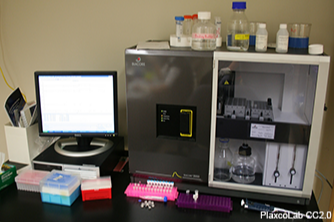Instruct offer a wide range of techniques to study macromolecular interactions, including circular dichroism, surface plasmon resonance (SPR), thermal shift assay and calorimetry.
Instruct has 12 centres offering Molecular Biophysics across Europe. Navigate the map and click on the pins to discover centres near you.
Instruct offers a large panel of state-of-the-art equipment and expertise in biochemistry and biophysics to perform quality control and functional analysis on protein samples.
Techniques are provided for the biophysical characterization of the structure, function and stability of biological macromolecules like proteins, nucleic acids, lipids and their complexes (Circular Dichroism, Differential Scanning Fluorescence, Differential Scanning Calorimetry, Dynamic Light Scattering, UV/Vis Spectrometry) and kinetic and thermodynamic parameters of their iteration (Microscale Thermophoresis, Surface Plasmon Resonance, Isothermal titration Calorimetry).
Surface Plasmon Resonance (SPR) is based on measuring the changes that occur in the refractive index of a metal surface, typically gold, upon binding of different materials, in this case the biomolecules of interest. The changes can be read in real time, and they depend predominantly on the total mass on the surface, thus labelling of the molecules of interest is not required for detection.
The principle assay setup is based on a biosensor on which a first molecule, the ligand, is immobilised by covalent linking through Cys or Lys ligation, or by any affinity tag such as antibodies, biotin, GST, His, etc. A second molecule, the analyte, is injected over the surface with the immobilised ligand and the change of signal due to the binding is monitored in real time with a time resolution within the second.
Different SPR technologies are implemented for studying interactions between biological partners. In general, within the idiosyncrasies of different machines, SPR allows the determination of equilibrium constants, kinetics association (ka) and dissociation (kd) rates, and thermodynamic constants (dH, TdS). SPR can also be used for the determination of sample concentration, the characterisation of molecular assembly, epitope mapping and semi-high throughput ligand screening.
SPR can be used with all classes of biological molecules from small ligands (larger than 200 Da), to macromolecules (proteins, polysaccharides, lipids and nucleic acids) and large complexes and particles (liposomes, virus).
Thermal shift assay is a thermodenaturation assay for monitoring the thermal stability of proteins and investigate factors affecting this stability. This rapid and simple technique is used in high-throughput mode to screen optimal buffer conditions, ligands, cofactors and drugs for purified proteins. Two methods to monitor protein denaturation are available: a differential scanning fluorimetry (DSF) method and a differential static light scattering method (DSLS). The optimisation of proteins solubility and stability properties improvesthe success rate of structural studies. Changes in the thermal stability of the protein–ligand or protein-peptide complexes relative to the stability of the protein alone allow to rapidly identify promising complexes for further structural characterisation and to assign functions.
Studying the thermal stability of proteins and investigating buffer conditions, ligands, cofactors and drugs affecting this stability can be used to rapidly identify promising protein formulation and complexes for further structural characterisation.
Analytical ultracentrifugation (AUC) is a powerful technique for the characterisation of macromolecules and macromolecular self- and hetero-association processes in solution. Two types of complementary experiments, sedimentation velocity and sedimentation equilibrium, can be performed in an analytical ultracentrifuge which is a high-speed centrifuge equipped with an optical detection system. The observation of macromolecule or macromolecular complex sedimentation gives access to their hydrodynamic and thermodynamic properties, including their size, shape, molar mass, degree of heterogeneity, oligomeric state, stoichiometry, and binding constants.
Biological phenomena in general involve molecular recognition on an intramolecular or intermolecular level. Intramolecular processes involve ligand binding and interaction between different types of macormolecules, as the interaction between proteins or protein and DNA or RNA. Protein folding is an example for intermolecular recognition. The parameter describing the stability of such a system is the equilibrium constant of the free energy, itself the sum of enthalpy and entropy which are temperature dependent through the heat capacity change.
Modern calorimeters allow direct measurements of the enthalpy and the heat capacity change, with high precision and a limited amount of sample material. The instrument measures the heat flux between the sample and reference chamber as a result of chemical reactions or physical changes. At constant pressure or volume these changes can be directly correlated to changes in enthalpy and heat capacity. Recorded thermogramms yield direct information about the stability of the protein sample and the effect of added compounds as ligands. In the case of membrane proteins it is suitable to identify bound detergents.
Two basic calorimetric concepts are used in structural biology: Differential Scanning Calorimetry (DSC) and Isothermal Titration Calorimetry (ITC). In DSC during constant heat increase of the sample temperature changes are monitored, whereas in ITC the power necessary in order to maintain an equal temperature between the sample and a reference cell is observed upon e.g. addition of a ligand.
Circular dichroism (CD), the differential absorption of left- and right-handed circularly polarised light, is an excellent spectroscopic method for studying conformations adopted by proteins and nucleic acids in solution. Although not able to provide detailed residue specific information, CD measurements have two major advantages: they can be recorded on relatively small amounts of material in a wide range of buffers and they allow to monitor any structural alterations. The CD is one of the best method:
Microscale Thermophoresis (MST) is a powerful new technology for quantifying biomolecular interactions in a few microliter solution. The MST method is based on thermophoresis, the directed movement of molecules in a temperature gradient, which strongly depends on a variety of molecular properties such as size, charge, hydration shell or conformation. Virtually any molecule can be analysed. The thermophoresis is detected and quantified using either covalently attached or intrinsic fluorophores. For example, the thermophoresis of a protein typically differs significantly from the thermophoresis of a protein–ligand complex due to binding-induced changes in size, charge and solvation energy. For deriving binding constants, multiple capillaries with constant concentrations of protein and increasing concentration of ligand are scanned consecutively and thermophoresis is detected. The analysis software is used to plot and fit the change in thermophoresis to yield a Kd. This technology has several advantages over other standard techniques to analyse interactions, such as surface plasmon resonance (SPR) and isothermal microcalorimetry (ITC). It can measure affinities in free solution without surface immobilisation with low sample consumption and within sub-nM to mM range. Experiments can be carried out with a broad range of solution conditions, including detergent mixtures and complex bioliquids.
The availability in Instruct of the most advanced instruments for Multi Angle Dynamic Light Scattering (MALS) combined quasi-elastic light scattering (QELS) detectors allows the user to carry out a detailed biophysical characterisation of biomolecules in solution. The measure of the intensity of laser light, scattered at different angles by macromolecules passing through the flow cell and the analysis of the autocorrelation function of the laser light fluctuations allow the calculation of: the concentration of the biomolecules in solution, the molecular weight, the radius of gyration (rg), the translational diffusion coefficient (Dt) and the related hydrodynamic radius (rh). The technique is extremely sensitive and provides information on the shape and aggregation state of the biomolecules in solution.




